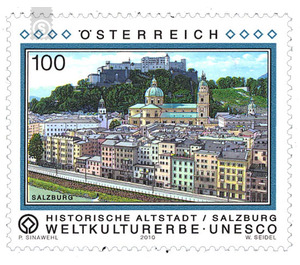UNESCO world heritage - Austria / II. Republic of Austria 2010 - 100 Euro Cent
Theme: Architecture
| Country | Austria / II. Republic of Austria |
| Issue Date | 2010 |
| Face Value | 100.00 |
| Edition Issued | 250,000 |
| Printing Type | Typography |
| Stamp Type | Commemorative |
| Item Type | Stamp |
| Chronological Issue Number | 2186 |
| Chronological Chapter | OOS-OE2 |
| SID | 841775 |
| In 60 Wishlists | |
No question: the historic old town of Salzburg is probably one of the most beautiful places in Europe - and by the appointment as a World Heritage Site by the UNESCO in 1997, this fact found its well-deserved international recognition. About the topography of the city: To a certain extent as a "historical lifeline" the Salzach, coming from the south of the forerunners of the Alps, meanders through the middle of the old town and divides it into two halves - into the so-called right or left bank of the Salzach. The left bank of the Salzach represents the "still older part" of the city, here the earliest settlement remains from Roman times were found. From one side to the other you can reach the Nonntaler Bridge, the Mozartsteg, the Staatsbrücke, the Makartsteg and the Müllner Steg. The old part of the town is framed by Mönchsberg, on which the famous fortress Hohensalzburg towers, and on the right side by the mighty Kapuzinerberg. For a true Salzburg, the term "mountain" may seem a bit over the top, but in fact you can take long walks on both city hills and escape the hectic bustle of the many streets and squares for a few hours. A climb is worthwhile in any case, you can enjoy from here the most beautiful panoramic views and "postcard views" on Salzburg. The old town itself, with its many different architectural styles, is a true architectural treasure chest. If you stroll through the many narrow alleyways, you will find buildings from the Middle Ages and Romanesque period as well as buildings from the Renaissance, Baroque and Classicist era of the monarchy - hardly an epoch that does not leave their mark on Salzburg Has. Since the old town of Salzburg on the one hand pedestrian area and on the other hand is relatively small, it is ideal for walking - from the Nonntal in the south to the Müllnerhügel in the north you can walk comfortably in about twenty minutes. Among the most impressive buildings are certainly the well-known Salzburg Cathedral, the aforementioned fortress Hohensalzburg, the residence, the monastery of St. Peter, the Franciscan and the University Church, the buildings in the festival district and of course the impressive Felsenreitschule. One thing is certain: If you visit Salzburg, it is recommended to bring a little time and be captivated and enchanted by the unique atmosphere and the lively city life. Whether art enjoyment, shopping, walk or local visit - the old town of Salzburg offers many charming sites.


